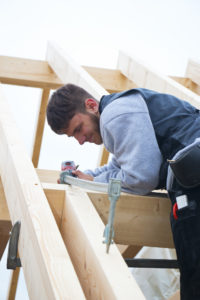The UK Government has set the target for housebuilding to reach 300,000 homes per year. This provides suppliers with a number of issues, none more so than to provide a balance of affordabl e homes, whilst doing so sustainably.
e homes, whilst doing so sustainably.
Timber frames and Modern Methods of Construction (MMC) provide a sustainable solution for developers to construct houses in a controlled environment.
Benefits of Off-Site Construction
Off-Site Construction provides an opportunity to construct properties out with the parameters of a traditional construction site. The advantages of Off-Site Construction include:
- The houses are constructed in a controlled factory environment, therefore, negating the effects of bad weather & other external factors delaying a project
- The controlled environment ensures greater quality-built properties
- Properties are built far more sustainably, due to the reduction in waste materials within the controlled environment
- Properties can be built at a much swifter pace
UK Off-Site Construction & Timber Frame Market Share
There has been significant growth in the Off-Site Timber Frame market throughout the last few years. In terms of overall market share in the UK for construction of housing properties it amounts to around a 25% share, in Scotland however, it has over 75% market share!
There are significant changes in England, in particular, to increase the market share of off-site construction, especially due to the sustainable benefits it provides.
Timber as a Sustainable Solution
Timber provides a sustainable resource, as trees that are felled as a result of collecting the timber resource can be replenished instantly, topping up the resource. Once trees grow they take in carbon from the environment. The positive sustainable factors are further illustrated as for every 1 cubic metre of timber, it stores around 1 metre tonne of carbon.
Energy Efficiency of Timber Frame Housing
Timber Frame houses are energy efficient due to the effective insulation that timber provides as a resource. It provides a reduction in energy escaping the property and thus assists with resident fuel bills.
Timber Frame Quality & Industry Standards
The Structural Timber Association (STA) provides guidance on quality standards, which include ST Assure, which provides various levels of quality management – Gold, Silver and Bronze standards.
Timber’s Fire Resistance Elements
Completed timber frames comply with various building regulations and warranty providers in relation to fire resistance. The STA introduced a series of fire tests which prompted a set of comprehensive guidance, this highlights safety measures that could appropriately mitigate any fire risks within the frame during construction.
The STA have a specialist team that constantly evaluate timber frame guidance and update the guidance appropriately with new developments within the industry.
Career Opportunities in the Timber Sector
Whilst there can be challenges in attracting enough young people to enter the construction sector, there are a range of roles available related to designing Timber Frame / MMC:
- Accountancy
- Commercial
- Factory
- Haulage
With thanks to Tom Fairlie, Sales Director, Walker Timber Engineering
